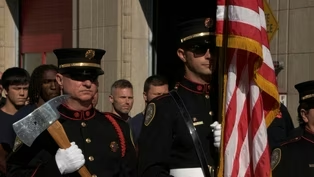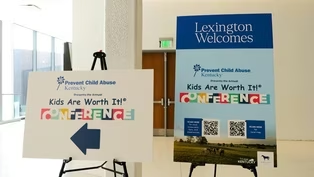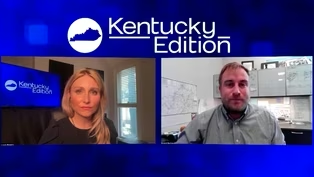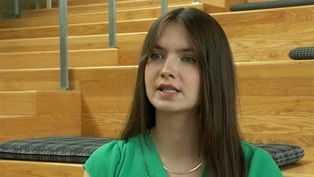
Immigrant Influence
Clip: Season 3 Episode 73 | 3m 35sVideo has Closed Captions
How immigration shaped Northern Kentucky.
From the architecture to the foods like Goetta, the German influence on Northern Kentucky is still visible today. But how did that come about? We spoke with Doctor Paul Tenkotte, professor of history at Northern Kentucky University, to hear how immigration has influenced the region.
Problems playing video? | Closed Captioning Feedback
Problems playing video? | Closed Captioning Feedback
Kentucky Edition is a local public television program presented by KET

Immigrant Influence
Clip: Season 3 Episode 73 | 3m 35sVideo has Closed Captions
From the architecture to the foods like Goetta, the German influence on Northern Kentucky is still visible today. But how did that come about? We spoke with Doctor Paul Tenkotte, professor of history at Northern Kentucky University, to hear how immigration has influenced the region.
Problems playing video? | Closed Captioning Feedback
How to Watch Kentucky Edition
Kentucky Edition is available to stream on pbs.org and the free PBS App, available on iPhone, Apple TV, Android TV, Android smartphones, Amazon Fire TV, Amazon Fire Tablet, Roku, Samsung Smart TV, and Vizio.
Providing Support for PBS.org
Learn Moreabout PBS online sponsorshipmonth's topic focuses on race.
From architecture to foods like data that we heard about on Monday, the German influence of northern Kentucky is still very visible today.
But how did that even come about?
We spoke with Doctor Paul turncoat, a professor of history here at Nku to hear how immigration has influence the region too.
♪ So by about 18, 40.
>> We know that Catholic tournament immigrants were arriving in the city of Cincinnati, northern Kentucky by about 200 people a day.
And by the time they established the church where and now mother of God church as it specifically German-speaking congregation.
Already there are say 30 or 40 families in 18, 41 when the church was established 12 years later, it was estimated that there were 1500 Catholic Families in Covington alone.
So that would have been phenomenal because covenants population was only about 10,000 at the time.
So we know that most of those immigrants were German immigrants.
Many were German where German Lutherans and the many of them were Arash Catholics as well.
And so the way they set up their churches was to reflect what they saw when Germany.
So what you're seeing around you is the church that they constructed in 18, 70 71 and German American artists, very well-known artists from across the country and also from this region, pain at the beautiful murals pain at Seco work on the ceilings, on the walls that you see stained glass windows were imported from Germany from Myron Company.
So it showed the gifts and the talents that the German people in this instance had to offer to their city and at and felt that this was actually a civic achievement.
This was something that they were doing to beautify the city themselves and to show that they as immigrants had arrived in American society, they're proud of their heritage, but they're equally proud of the fact that they have become Americans in every sense of the word.
The reasons for immigration really are strongly consistent throughout history.
And most immigration historians will tell you that the main reason why people immigrate is for economic opportunity.
The second reason would be for political opportunities.
So much of it.
Our immigration is coming from Central America now currently.
And there's political unrest and Central America and also lack of economic opportunity.
So this is what Latinx people are seeking and the United States and they're finding and that's true of Asian population.
South Asian populations, people from India and likewise are also seeking those opportunities because this area is part of that great Golden Triangle of Cincinnati, Covington Newport.
On the one hand and then Louisville and Lexington right as well.
So you have this prosperity and the return.
♪ >> The city of Covington will celebrate its German heritage this weekend at Oktoberfest featuring all things German
Video has Closed Captions
Clip: S3 Ep73 | 3m 18s | Public hearings on JCPS overhaul end. (3m 18s)
Video has Closed Captions
Clip: S3 Ep73 | 1m 29s | Kentucky honors those killed in the 9/11 terrorist attacks. (1m 29s)
Video has Closed Captions
Clip: S3 Ep73 | 2m 38s | Annual Kids Are Worth It conference held in Lexington. (2m 38s)
Video has Closed Captions
Clip: S3 Ep73 | 6m 43s | A look at the week in Kentucky Politics with NPR's Ryland Barton. (6m 43s)
Saint Elizabeth Social Workers
Video has Closed Captions
Clip: S3 Ep73 | 3m 22s | Northern Kentucky doctors and social workers partner to help more people get counseling. (3m 22s)
Student Reflects on Presidential Debate
Video has Closed Captions
Clip: S3 Ep73 | 2m 46s | A student's perspective on the presidential debate. (2m 46s)
Providing Support for PBS.org
Learn Moreabout PBS online sponsorship
- News and Public Affairs

Top journalists deliver compelling original analysis of the hour's headlines.

- News and Public Affairs

FRONTLINE is investigative journalism that questions, explains and changes our world.












Support for PBS provided by:
Kentucky Edition is a local public television program presented by KET





